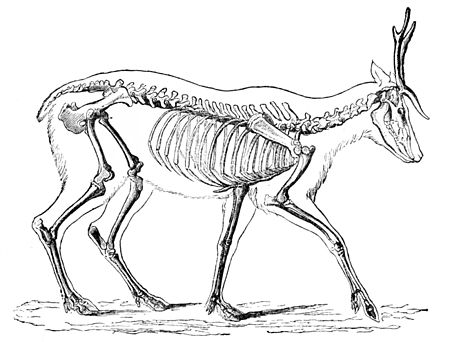cellent illustration. Here we have not only the sharp angles, but lever-like adjustment of the several bones.
From these arises the power possessed by many animals to bound or leap enormous distances. The kangaroo has been known to leap twenty feet. The jerboa, when pursued, will pass over nine feet at a bound, and repeats so rapidly that a swift horse can scarcely overtake it. The greyhound and the hare will pass over sixteen feet at a stride. Animals of great weight and moderate speed have nearly straight limbs. Those of the deer are more angular than those of a horse, and those in the wing of a bird more angular than those of the fleetest quadruped.
Fig. 3.

Skeleton of the Deer (after Pander and d'Alton). The bones in the extremities of this, the fleetest of quadrupeds, are inclined very obliquely toward each other, and toward the scapular and iliac bones. This arrangement increases the leverage of the muscular system, and confers great rapidity on the moving parts. It augments elasticity, diminishes shock, and indirectly begets continuity of movement.
The forms of joints which predominate in the animal kingdom are the hinge and the ball and socket. The latter gives to the extremities their extraordinary range of motion, and a power of rotation so indispensable, as we will see, to the effectiveness of all the organs of locomotion.
It has been shown that a spiral configuration occurs in the bones and joints of the wing of the bat and the bird, and in the extremities of most quadrupeds. "The bones of animals are, as a rule, twisted levers, and act after the manner of screws." Thus it is that their traveling surfaces in progression may be turned at almost any angle, getting from the resisting media in which they move as much propelling power as possible, with a minimum of slip or waste.
It is because the traveling surfaces of animals "are screws struct-
